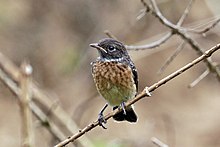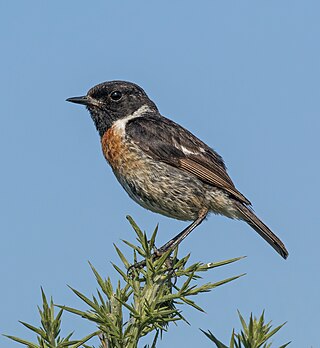
The European stonechat is a small passerine bird that was formerly classed as a subspecies of the common stonechat. Long considered a member of the thrush family, Turdidae, genetic evidence has placed it and its relatives in the Old World flycatcher family, Muscicapidae. It is found across Europe, as far east as Ukraine and the South Caucasus, and in parts of North Africa.

The pied bush chat is a small passerine bird found ranging from West Asia and Central Asia to the Indian subcontinent and Southeast Asia. About sixteen subspecies are recognized through its wide range with many island forms. It is a familiar bird of countryside and open scrub or grassland where it is found perched at the top of short thorn trees or other shrubs, looking out for insect prey. They pick up insects mainly from the ground, and were, like other chats, placed in the thrush family Turdidae, but are now considered as Old World flycatchers.

The African stonechat or common stonechat is a species of the Old World flycatcher family (Muscicapidae), inhabiting sub-Saharan Africa and adjacent regions. Like the other chats, it was long assigned to the thrush family (Turdidae), to which the chats are convergent. Its scientific name refer to its appearance and habitat and means "collared rock-dweller": Saxicola from Latin saxum ("rock") + incola, torquatus, Latin for "collared".

The olive bee-eater or Madagascar bee-eater is a near passerine bee-eater species in the genus Merops. It is native to the southern half of Africa where it is present in Angola; Botswana; Burundi; Comoros; Democratic Republic of the Congo; Djibouti; Eritrea; Ethiopia; Kenya; Madagascar; Malawi; Mayotte; Mozambique; Namibia; Rwanda; Somalia; South Sudan; Sudan; Tanzania; Uganda; Zambia; Zimbabwe. It is a common species with a wide range so the International Union for Conservation of Nature has rated their conservation status as "least concern".
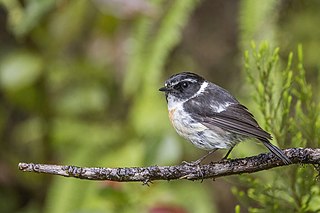
The Réunion stonechat is a species of stonechat, endemic to the island of Réunion. This small passerine bird is common in clearings and open mountain bushlands there up to 2600 metres above sea level, including in the plains around Piton de la Fournaise.

The Cape bunting is a passerine bird in the bunting family Emberizidae.

The black-faced munia is a species of estrildid finch found in Indonesia and East Timor. It occurs in a wide range of habitats including artificial landscapes, forest, grassland and savannah. It was first described by the Swedish naturalist Carl Linnaeus in the twelfth edition of his Systema Naturae in 1766. The IUCN has evaluated the status of this bird as being of least concern.

The yellow-green grosbeak is a species of grosbeak in the family Cardinalidae.
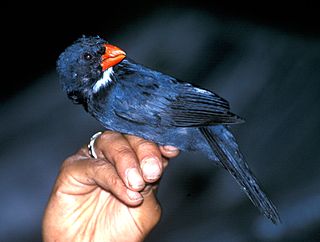
The slate-coloured grosbeak is a species of grosbeak in the family Thraupidae. Most of its range is the Amazon in South America, but it is also found in forests of the Chocó in Ecuador and Colombia, and southern Central America from Panama to Honduras.

The red-tailed vanga is a species of bird in the family Vangidae. It is endemic to Madagascar.

The balicassiao is a species of passerine bird in the family Dicruridae. It is endemic to the Philippines.

The crested drongo is a passerine bird in the family Dicruridae. It is black with a bluish-green sheen, a distinctive crest on the forehead and a forked tail. There are two subspecies; D. f. forficatus is endemic to Madagascar and D. f. potior, which is larger, is found on the Comoro Islands. Its habitat is lowland forests, both dry and humid, and open savannah country. It is a common bird and the IUCN has listed it as "least concern".

The purple-throated euphonia is a songbird species in the family Fringillidae. It was formerly placed in the Thraupidae.

The rusty-margined flycatcher is a species of bird in the family Tyrannidae, the tyrant flycatchers.
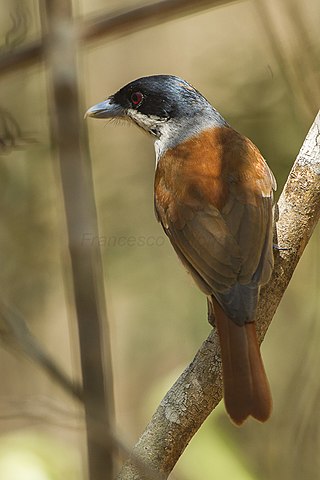
The rufous vanga is a species of bird in the family Vangidae. It is monotypic within the genus Schetba. It is endemic to Madagascar, where its natural habitats are subtropical or tropical dry forest and subtropical or tropical moist lowland forest.

The fulvous-crested tanager is a species of bird in the family Thraupidae, the tanagers.

The spotted tanager is a species of bird in the tanager family Thraupidae. It is found in Bolivia, Brazil, Ecuador, French Guiana, Guyana, Peru, Suriname, and Venezuela. Its natural habitats are subtropical or tropical moist lowland forests and subtropical or tropical moist montane forests.

The hook-billed vanga is a species of bird in the family Vangidae. It is endemic to Madagascar. Its natural habitats are subtropical or tropical dry forest, subtropical or tropical moist lowland forest, and subtropical or tropical moist montane forest.
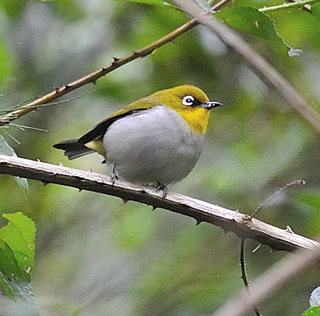
The Malagasy white-eye is a species of bird in the white-eye family, Zosteropidae. Found in Madagascar and Seychelles, its natural habitats are subtropical or tropical dry forests, subtropical or tropical moist lowland forests, subtropical or tropical mangrove forests, and subtropical or tropical moist montane forests.

The Réunion olive white-eye is a species of bird in the family Zosteropidae. It is found on Réunion. Its natural habitats are boreal forests and subtropical or tropical high-altitude grassland.

